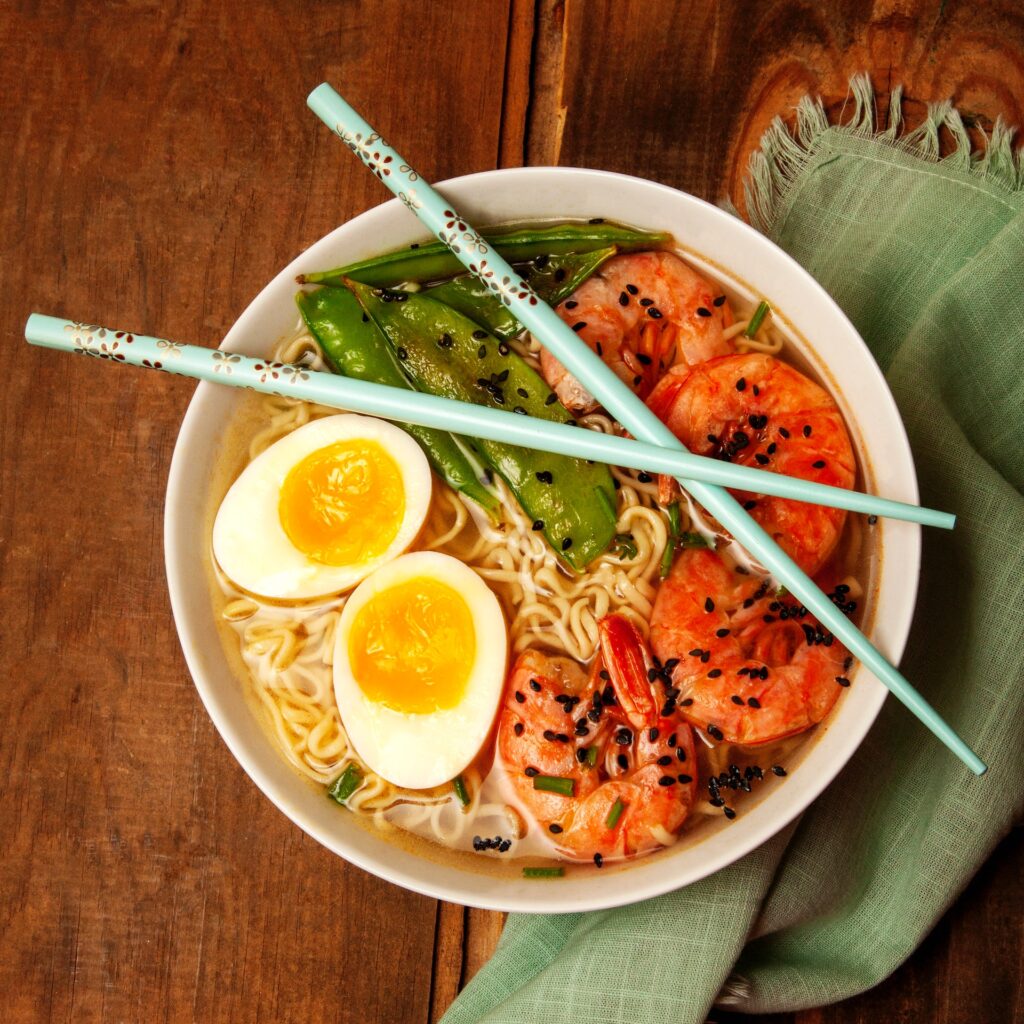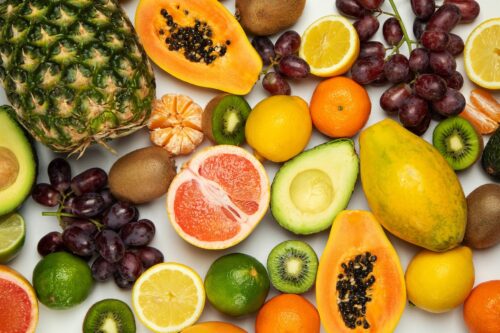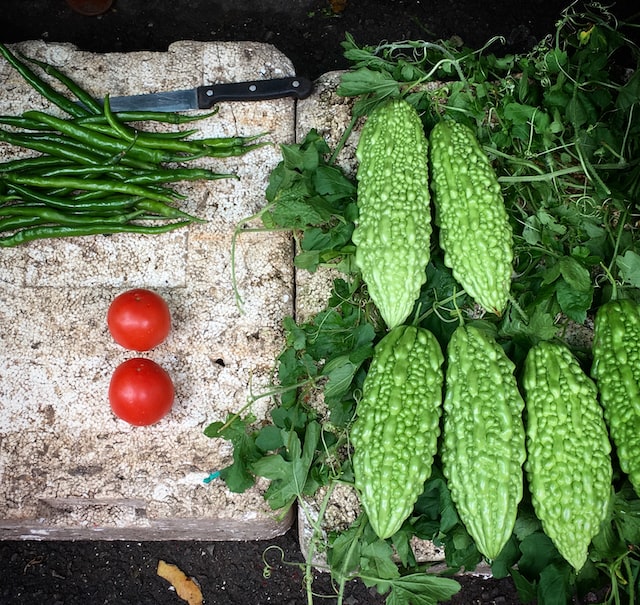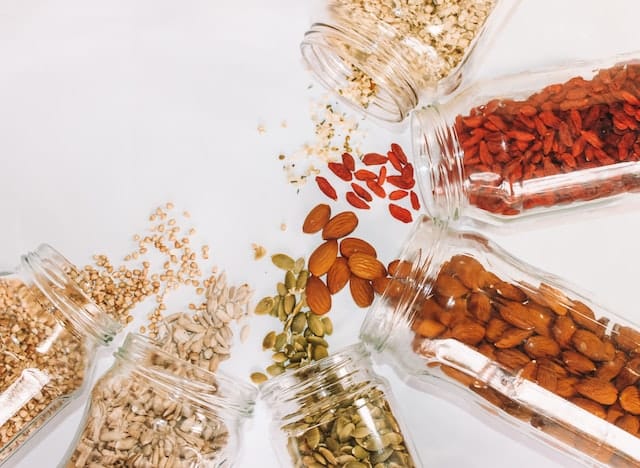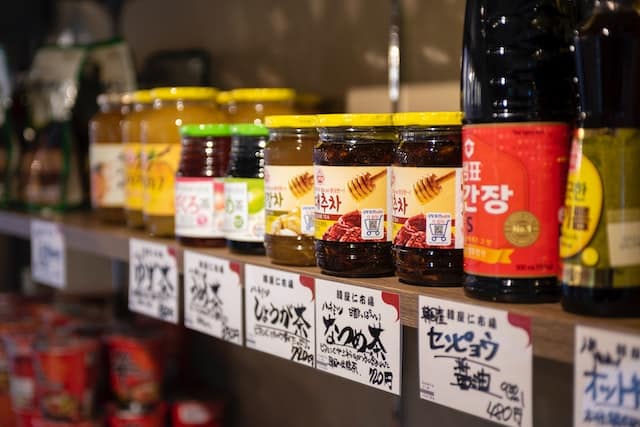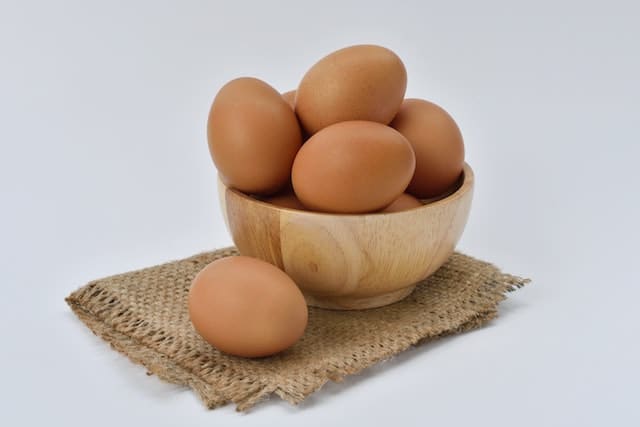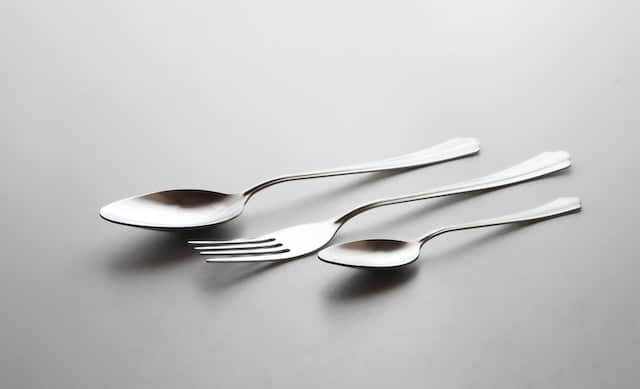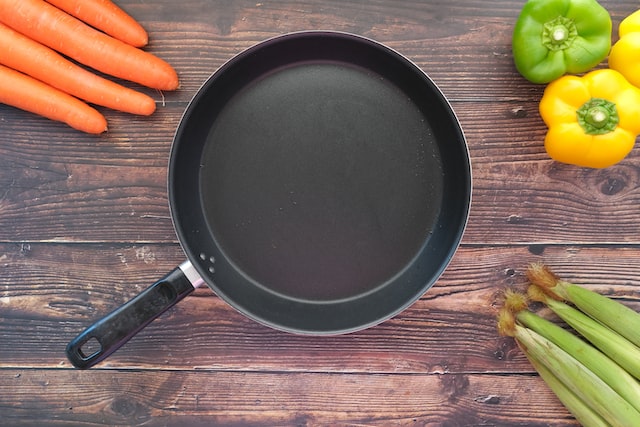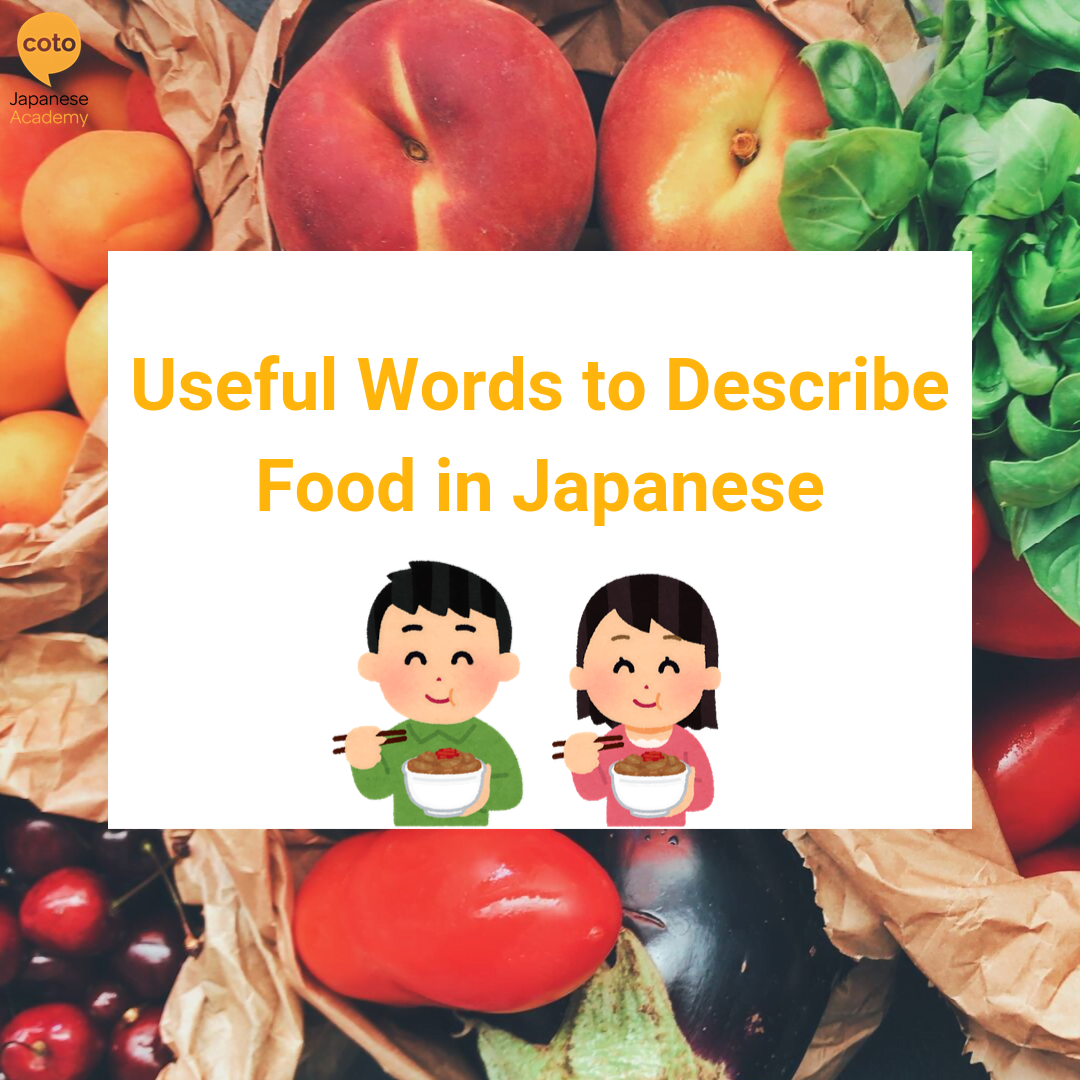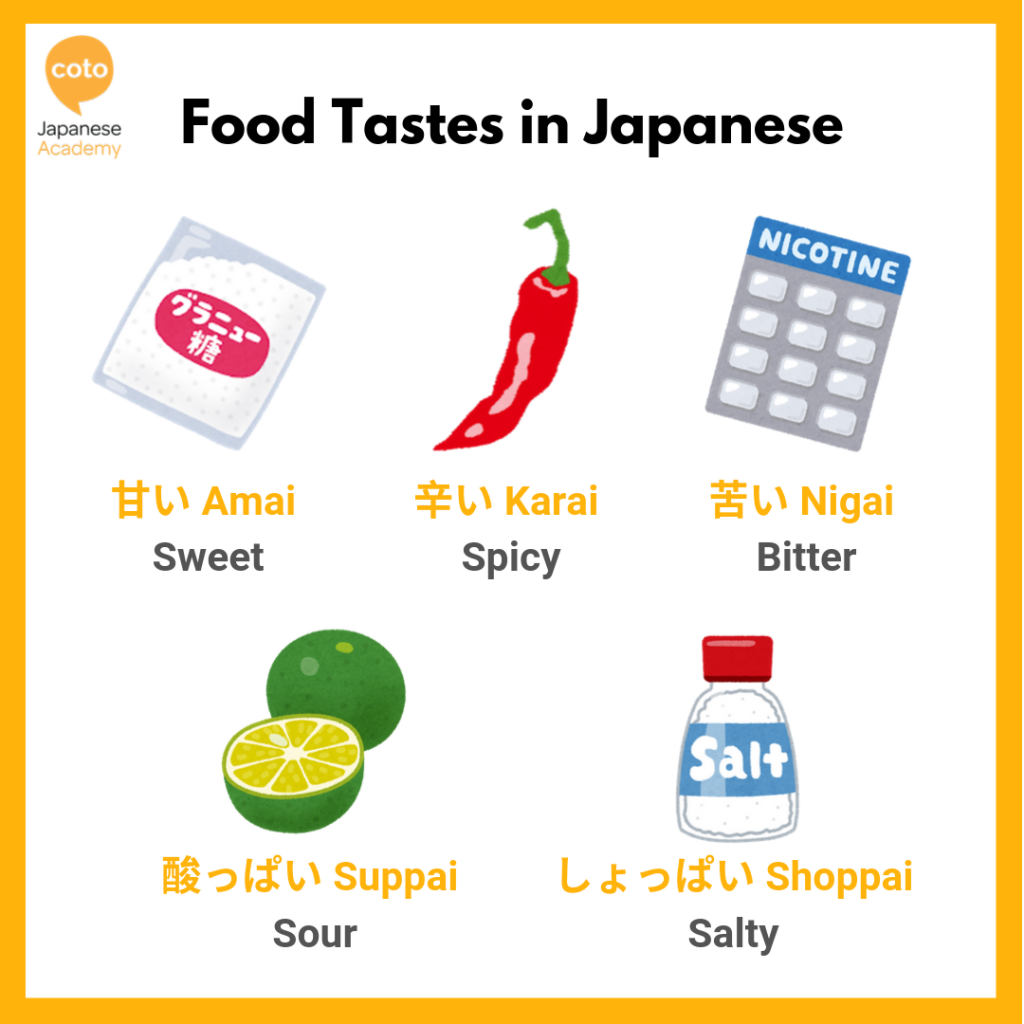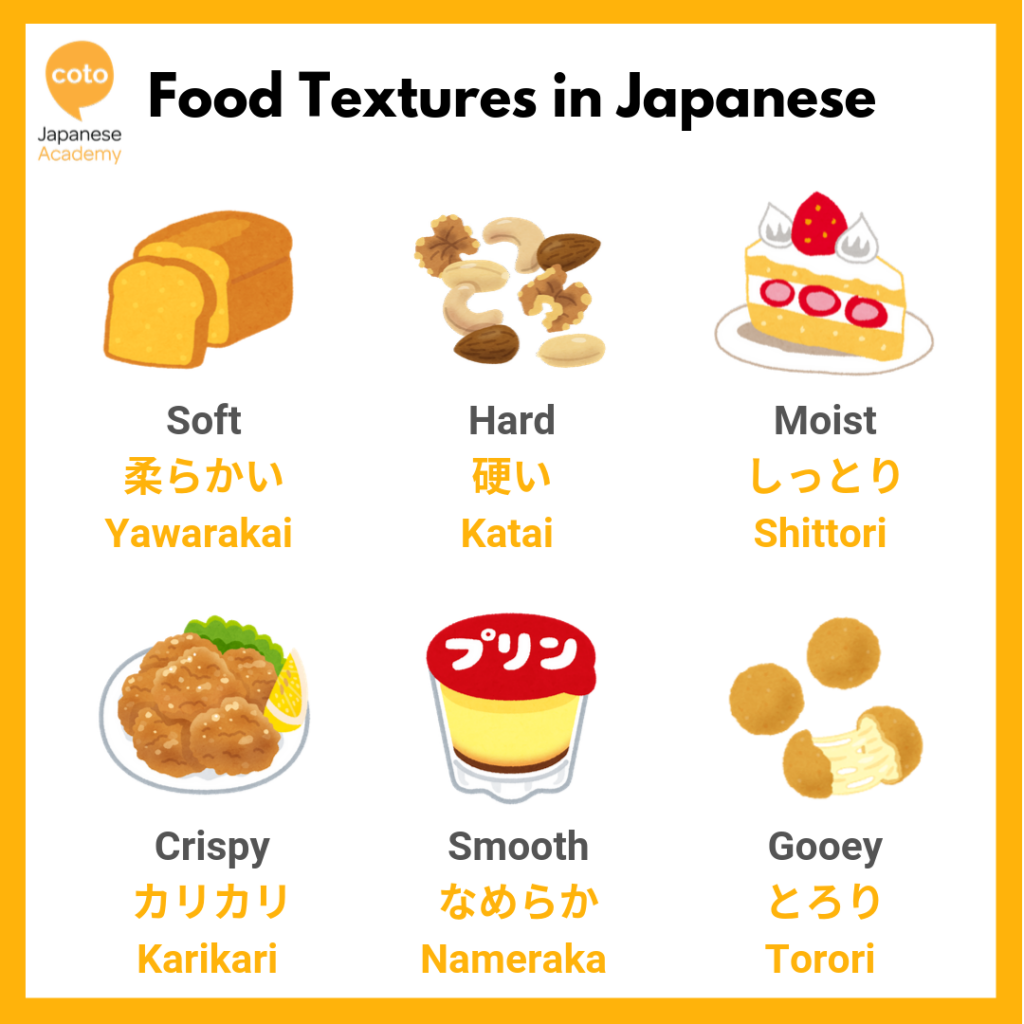Both borrowed words and native words are commonly used for food items in Japanese, and many foods are called by both the native and English-derived terms, in which case the more common/established of the two will be the one used here.
フルーツ(Furuutsu)/Fruit
| Kana | Romaji | English |
| りんご | ringo | apple |
| ぶどう | budou | grapes |
| なし | nashi | Japanese pear |
| ようなし | younashi | (western) pear |
| かき | kaki | persimmon |
| オレンジ | orenji | orange |
| レモン | remon | lemon |
| ライム | raimu | lime |
| グレープフルーツ | gureepufuruutsu | grapefruit |
| バナナ | banana | banana |
| いちご | ichigo | strawberry |
| ブルーベリー | buruuberii | blueberry |
| さくらんぼ | sakuranbo | cherry |
| メロン | melon | green melon (honeydew) |
| すいか | suika | watermelon |
Random tidbit: Japanese apples are much larger than western apples, while the watermelons are rather small.
やさい(Yasai)/Vegetables
| Kana | Romaji | English |
| にんじん | ninjin | carrots |
| セロリ | serori | celery |
| レタス | retasu | lettuce |
| キャベツ | kyabetsu | cabbage |
| トマト | tomato | tomato |
| ねぎ | negi | green onion (scallions) |
| たまねぎ | tamanegi | (round) onion |
| ポテト | poteto | potatoes |
| ブロッコリー | burokkorii | broccoli |
| ピーマン | piiman | bell pepper, green pepper (Fr. piment) |
| まめ | mame | beans (in general) |
| ピース | piisu | peas |
| コーン | koon | corn |
Japanese cuisine uses a lot of vegetables, including many that are unknown in the west. One Japanese vegetable you might be aware of is the daikon, which is a giant white radish.
にくとシーフード(Niku to Shiifuudo)/Meat and Seafood
| Kana | Romaji | English |
| ぎゅうにく | gyuuniku | beef |
| ぶたにく | butaniku | pork |
| ハム | hamu | ham |
| とりにく | toriniku | chicken |
| たまご | tamago | egg |
| さかな | sakana | fish |
| えび | ebi | shrimp, prawn, lobster |
| かに | kani | crab |
| たこ | tako | octopus |
Tori «bird» is used to refer to chicken in the context of food, since turkey and other poultry is rarely found in Japan. Similarly, niku «meat» without further specification usually refers to beef, though butaniku (pork) is cheaper and consumed in greater quantity.
And of course, let’s not forget toufu (soy bean curd), which by itself is mostly flavorless but easily absorbs the flavor of anything it’s cooked with. In Japan it’s not just a vegetarian food, but a regular ingredient in Japanese cuisine.
にゅうせいひん(Nyuuseihin)/Dairy Products
| Kana | Romaji | English |
| ぎゅうにゅう・ミルク | gyuunyuu/miruku | milk |
| チーズ | chiizu | cheese |
| ヨーグルト | yooguruto | yogurt |
| アイスクリーム | aisukuriimu | ice cream |
Dairy products are not used in traditional Japanese cuisine, but they can still be found in Japanese supermarkets and in western food. Both gyuunyuu and miruku are common words for milk.
こめとめんとパン(Kome to Men to Pan)/Rice, Noodles, Bread
| Kana | Romaji | English |
| こめ | kome | rice (uncooked) |
| ごはん | gohan | rice (cooked) |
| げんまい | genmai | brown rice |
| うどん | udon | udon (wheat noodles) |
| そうめん | soumen | somen (thin noodles) |
| そば | soba | soba (buckwheat noodles) |
| ラーメン | raamen | ramen (Chinese noodles) |
| パン | pan | bread, rolls, pastries |
| かしパン | kashipan | sweet bread, pastries |
| ピザ | piza | pizza |
Several notes this time:
- Japanese rice is short grain, as opposed to the long grain rice usually used in the west. Short grain rice is somewhat sticky and clumps together, making it easy to eat with chopsticks.
- Japanese noodles, especially somen and soba, can be served hot in a soup or cold with a dipping sauce. Noodle dishes are a popular lunch food in Japan.
- The «ramen» that we know is really just instant noodles. Real ramen is a Chinese-style Japanese noodle soup with real broth and various toppings that vary by region.
- Pan in Japanese can refer to any sort of bread or pastry, and is more of a snack than a staple meal item.
のみもの(Nomimono)/Drinks
| Kana | Romaji | English |
| みず | mizu | water |
| おちゃ | ocha | green tea, tea in general |
| にほんちゃ | nihoncha | Japanese green tea |
| むぎちゃ | mugicha | Japanese iced barley tea |
| こうちゃ | koucha | black tea (lit. «crimson tea») |
| コーヒー | koohii | coffee |
| ぎゅうにゅう・ミルク | gyuunyuu/miruku | milk |
| ジュース | juusu | juice |
| オレンジジュース | orenjijuusu | orange juice |
| レモネード | remoneedo | lemonade |
| ソーダ | sooda | soda, pop |
| おさけ | osake | sake (rice wine), alcohol in general |
| にほんしゅ | nihonshu | Japanese sake |
| ワイン | wain | wine |
| ビール | biiru | beer |
As you might expect, Japanese people drink a lot of tea, both green and other varieties, not necessarily with meals, but often alone or with snacks.
Koohii for coffee was coined back when «f» was transcribed as «h» in borrowed words, giving ハ、ヒ、フ、ヘ、ホ rather than the more modern ファ、フィ、フ、フェ、フォ.
ちょうみりょうとやくみ(Chomiryou to Yakumi)/Seasonings and Condiments
| Kana | Romaji | English |
| しょうゆ | shouyu | soy sauce |
| あぶら | abura | oil |
| す | su | vinegar |
| みりん | mirin | sweet cooking sake |
| しお | shio | salt |
| こしょう | koshou | pepper |
| さとう | satou | sugar |
| わさび | wasabi | wasabi (Japanese «horseradish») |
| ごま | goma | sesame seeds |
| バター | bataa | butter |
| ケチャップ | kechappu | ketchup |
Real wasabi is a grated root; the green paste found outside of Japan is a cheaper substitute made from horseradish and mustard, two related plants.
わしょく(Washoku)/Japanese Food
| Kana | Romaji | English |
| すし | sushi | sushi (sweet vinegared rice with raw seafood, in various shapes) |
| さしみ | sashimi | sashimi (thinly sliced raw fish over sushi rice) |
| てんぷら | tenpura | tempura (battered and fried vegetables and seafood) |
| やきとり | yakitori | yakitori (grilled chicken skewers) |
| やきにく | yakiniku | yakiniku (grilled beef and vegetables) |
| やきざかな | yakizakana | grilled fish |
| やきそば | yakisoba | yakisoba (fried noodles, usually udon or ramen-like, with ham/sausage and vegetables) |
| すきやき | sukiyaki | sukiyaki (too difficult to explain here) |
| おこのみやき | okonomiyaki | okonomiyaki («Japanese pancakes», with meat or seafood and vegetables inside) |
| とんかつ | tonkatsu | fried pork cutlet |
| カレー・カレーライス | karee/karee raisu | Japanese curry with rice |
| コロッケ | kurokke | croquette (fried mashed potato patty with meat/seafood/vegetables) |
| ぎょうざ | gyouza | Chinese style fried dumplings (potstickers) |
| みそしる | misoshiru | miso soup (miso is a soy-based paste) |
| つけもの | tsukemono | Japanese pickles |
This particular list is far from complete, but includes a number of items that are familiar to westerners or otherwise easy to understand.
Yaki, from the verb yaku, can refer to frying, grilling, baking, or any similar cooking methods that apply direct heat. In contrast, there are several words that translate as «to steam», each for a different food item. Boiling, steaming, and other less fiery cooking methods are used more in Japanese cuisine than in western cooking.
Most meat-based dishes only originated in the last century or so, since consumption of meat was banned for most of Japanese written history.
Although not strictly native to Japan, Japanese karee is quite unlike Indian-style curry and definitely unique to Japan.
ようしょく(Youshoku)/Western Food
| Kana | Romaji | English |
| スープ | suupu | soup (any kind) |
| サラダ | sarada | salad |
| サンドイッチ | sandoitchi | sandwich |
| ハンバーガー | hanbaagaa | hamburger |
| ホットドッグ | hottodoggu | hotdog |
| フライドポテト | furaidopoteto | fries, fried potatoes |
| フライドチキン | furaidochikin | fried chicken |
| ステーキ | suteeki | steak |
| ピザ | piza | pizza |
| スパゲッティー | supgettii | spaghetti |
Note that despite the similar names, Japanese versions of western foods are typically adapted to Japanese tastes, with results like pizza with corn as a topping.
おやつとおかし(Oyatsu to Okashi)/Snacks and Sweets
| Kana | Romaji | English |
| チップ | chippu | chips |
| ポップコーン | poppukoon | popcorn |
| クッキー | kukkii | cookies |
| ケーキ | keeki | cake |
| パイ | pai | pie |
| アイスクリーム | aisukuriimu | ice cream |
| チョコレート | chokoreeto | chocolate |
| ゼリー | zerii | jelly (gelatin and similar desserts) |
| わがし | wagashi | traditional Japanese sweets (many of which are cracker-like) |
Dessert is not traditionally served after meals in Japan (except possibly fresh fruit), but sweet foods are eaten as snacks.
Having trouble understanding something? Anything I’ve missed? Please send your feedback using the contact form and help me improve this site. All questions, comments, and corrections are welcome.
You are here: Home/ Featured Posts/ 30+ Essential Japanese Words to Describe Food
Do you want to sound like a connoisseur of food in Japanese? Then let’s learn a medley of Japanese words and idioms in this post that describe the taste of food!
Other Posts:
- 50+ Japanese Words and Idioms about Love/Romance
- Japanese Money-Related Idioms and Slang Words
Words Meaning “Tasty”
- おいしい (also 美味しい): tasty, delicious
- うまい (also 美味い): tasty, yummy (casual);
- うめえ (more casual and masculine than うまい)
- コク/うま味(み)がある: have a deep/umami-flavour
- 絶品(ぜっぴん): one-of-a-kind food
- ジューシー: juicy
(Trivia) Former Prime Minister Shinzo Abe often used “juicy” to describe the taste of food, including tomato, beef, peach, melon, cucumber and grape. Just in case you are very keen to see him saying “juicy”, I’ve attached the YouTube video below where he describes many types of food as “juicy”.
Words Meaning “Taste Bad”
- 美味(おい)しくない: not tasty
- 私の好みではない: not my favourite/cup of tea
- 口(くち)に合(あ)わない : “does not suit my mouth” = not my cup of tea
- 不味(まず)い: taste bad
- 味(あじ)がしない: taste nothing
- ぬるい, 冷(さ)めた: lukewarm (not hot enough)
Intensifiers
- とても, とっても, かなり: “very”
(e.g.) とても/とっても/かなり美味しい
- めっちゃ: “very/really” (casual)
(e.g.) めっちゃおいしい/まずい
- 超 (ちょう, casual), 超絶 (ちょうぜつ, very casual/young): “very/really”
(e.g.) 超おいしい, うまい/まずい, 超絶おいしい, うまい/まずい
- マジ: “very/really” (casual)
(e.g.) マジうまい/まずい
- 激 (げき): “very/really” (casual)
(e.g.) 激ウマ (really good)、激マズ (really bad), 激辛 (げきから, extremely spicy)
- クソ: “bloody”, “goddamn” “af” (very casual)
(e.g.) クソうまい (bloody good)、クソマズい (taste like sh*t)
- 全然 (zenzen): very, unexpectedly
See the post below.
Meaning of 全然 (Zenzen) Without a Negative Form ない (Nai)
Specific Taste
- 甘(あま)い: sweet
- 甘(あま)ったるい: too sweet
- 酸(す)っぱい: sour
- 辛(から)い: hot/spicy; ピリ辛(から)/激辛 (げきから): a bit/extremely spicy
- しょっぱい: too salty
- 苦(にが)い: bitter
- 濃(こ)い, こってり: thick, heavy taste (e.g. こってりラーメン)
- 薄(うす)い (negative), さっぱり (positive): light taste
Soggy Noodles: 麺が伸びる
麺 (めん) が伸(の)びる literally means “(the noodles) get longer”, but actually means that the noodles “absorb water and become soggy”. The subject “麺が” is often omitted as in the second example below.
(e.g.)
麺が伸びるから、ゲームやめて食(た)べなさい!
The noodles will get soggy, so stop playing the game and eat them now!
伸びる前(まえ)に、どうぞ召(め)し上(あ)がってください!
I recommend you would eat the noodles before they get soggy!
* 召し上がる: sonkeigo of 食べる (eat)
Onomatopoeia
- ふわふわ: fluffy
- トロトロ: creamy
- モチモチ: like a mochi, chewy
- カリカリ, サクサク, シャキシャキ: crispy
(シャキシャキ is often used for a salad, and サクサク for snacks and cookies)
Japanese Idioms Related to Food
舌鼓を打つ
“舌鼓(したつづみ or したづつみ) を 打(う)つ” literally means ‘hit a “tongue-drum”‘, where 鼓 (つづみ) is a Japanese traditional hand drum. It figuratively means “you’re really impressed by the taste of food (and that makes you click your tongue)”. It is usually used in writing only, but you may use it in a conversation to describe delicious food in a joking and exaggerated way.
昨日 (きのう) は旅館(りょかん)の海鮮料理(かいせんりょうり)に舌鼓を打った
Yesterday, I “hit a tongue-drum” for (= was really impressed by/fully enjoyed the taste of) the seafood served at the ryokan (a Japanese-style hotel).
絵に描いた餅
絵(え)に描(か)いた餅(もち), literally meaning “mochi (Japanese rice cake) you draw on a picture”, is a Japanese idiom that means “(sounds good but) is unrealistic/impractical”, because it looks yummy but you cannot really eat it. It is very similar to the English phrase “pie in the sky” in terms of the meaning and nuance!
日本語 (にほんご) を10日 (か)でマスターするなんて計画 (けいかく)は、絵に描いた餅だ!
The plan to master Japanese in 10 days is a mochi you draw on a picture (the pie in the sky)!
More idioms related to mochi at explained in the following post:
Japanese Idioms about Mochi: 餅 (もち), Japanese Rice Cake!
朝飯前
朝飯前(あさめしまえ)literally means “before breakfast”, but figuratively means “a piece of cake”, “very easy”, i.e. easy enough to do before you eat breakfast. It is often used when someone asks you a favour and you reply to them in a light/casual/humorous way.
(e.g.)
そんなの朝飯前だよ。
That’s a piece of cake (for me).
あのチームに勝(か)つなんて、朝飯前だ。
That’s a piece of cake (for us) to beat the team.
ゴマをする
ゴマをする literally means “grind sesame seeds”, but figuratively means “be a sycophant” or “butter up/suck up to someone”. This idiom is so famous that the gesture of grinding seeds (rotating a closed hand on the palm of the other hand) refers to the act of sucking up to someone. According to one of the theories of the origin, the phrase started to be used to describe those people because ground sesame seeds, which are very sticky and stick to anything, resemble sycophants/brown-nosers tagging along with high-ranking people.
(e.g.)
彼は昇進 (しょうしん) するためなら、進(すす)んでゴマをする人間(にんげん)だ
He is a person who is willing to act obsequiously to get promoted.
See more Japanese idioms related to plants in the following post:
Eat Grass on the Road? Funny Japanese Idioms about Plants
Japanese Kanji Words for Japanese Food
- 寿司 (すし): sushi
- 和牛 (わぎゅう): wagyu; 和(わ) “Japanese” + 牛 (ぎゅう) “beef”
- 居酒屋 (いざかや): izakaya; 居(い)る ”stay” + 酒屋(さかや) “liquor shop”
- 味噌汁(みそ しる): 味噌(miso) + 汁(しる) “soup/liquid”
- 焼(や)き鳥(とり): yakitori; 焼(や)く “grill/fry/roast” + 鳥(とり) “bird/chicken”
- 餅(もち) mochi (Japanese rice cake)
- 抹茶(まっちゃ): matcha
- 蕎麦(そば): soba noodles
- 醤油(しょうゆ): soy sauce
- 牛丼 (ぎゅうどん): beef rice bowl; 丼 (don) = “rice bowl”
- 餃子(ぎょうざ): gyoza (pan-fried dumplings)
- 和食 (わしょく): Japanese food=日本料理 (にほんりょうり)
- 麺(めん) noodles; 麺類 (めんるい) = “types of noodles”
鍋(なべ): nabe, hot-pot
(Note) 鍋 looks similar to 禍 (か) “disaster”, so be careful (e.g. コロナ禍 “coronavirus-disaster”).
See also: A List of Japanese COVID-19 Words and Idioms
Difficult-to-Read Kanji Words for Food
- 海老 (えび): shrimp/prawn
- 小豆(あずき): red beans, adzuki beans
- 大豆(だいず): soybeans
- 納豆(なっとう): natto
- 海苔(のり): seaweed
- 茄子(なす): eggplant
- 素麺 (そうめん): Sōmen noodles
- 蕎麦(そば): soba noodles
- 人参 (にんじん): carrot
(Trivia) Computer machines often misunderstand 外国人参政権 as 外国 (foreign) + 人参 (carrot) + 政権 (government); it should be 外国人 (がいこくじん “foreigner”) + 参政権 (さんせいけん, “right to vote”)
Words for a Meal
- breakfast: 朝食(ちょうしょく)、朝飯(あさめし)、朝(あさ)ごはん
- lunch: 昼飯(ひるめし)、昼(ひる)ごはん、お昼(ひる)、ランチ
- dinner: 晩(ばん)ご飯(はん)、晩飯(ばんめし)、夜(よる)ごはん、夕飯(ゆうはん)、ディナー:
(Note 1): ランチ and ディナー sound like a nice meal (e.g) イタリアンランチ (Italian lunch), 高級(こうきゅう)ディナー (expensive dinner)
(Note 2): 朝飯, 昼飯 and 晩飯 sound more masculine/casual than 朝ごはん, お昼ごはん, and 夜(よる)ごはん
(Note 3): ごはん means not only “meal” but also “rice”. In contrast, おかず means “a dish that comes with rice”. Although おかず is often translated as “a side dish”, it rather refers to a main dish (e.g. beaf/chicken/pork) that Japanese people have with rice.
See Also
Ajimi or Dokumi? Meaning of Japanese Words for Tasting Food
By
Last updated:
March 17, 2023
Did you know that learning to cook in a foreign language is an amazing way to learn said language?
Memorizing Japanese words for food could be your shortcut to fluency.
Read on to learn 150 Japanese food words to describe your favorite dishes!
Contents
- Ingredients: 食材 (shokuzai)
-
- Fruit: 果物 (kudamono)
- Vegetables and Herbs: 野菜 (yasai) and ハーブ (hābu)
- Nuts and Grains: 木の実と穀物 (konomi to kokumotsu)
- Condiments: 調味料 (chōmiryō)
- Animal Products: 畜産物 (chikusanbutsu)
- Making Pastries: お菓子作り (okashizukuri)
- Counters: 助数詞 (josūshi)
- Preparation: 作り方 (tsukurikata)
-
- To Cook: 料理をする (ryōri o suru)
- Utensils/Tools 道具 (dōgu)
- Let’s Cook!: 料理をしよう!(りょうりをしよう!)
- How to Learn Japanese Through Cooking
Download:
This blog post is available as a convenient and portable PDF that you
can take anywhere.
Click here to get a copy. (Download)
Ingredients: 食材 (shokuzai)
Fruit: 果物 (kudamono)
apple: りんご (ringo)
citron: 柚子 (yuzu)
柚子 is a Japanese citrus fruit most closely related to lemons, but with a sweeter and more floral taste. Once the hot weather hits, you’ll find 柚子 everywhere and in everything.
fig: 無花果 (ichijiku)
strawberry: 苺 (ichigo)
watermelon: 西瓜 (suika)
cucumber: きゅうり(kyūri)
grape(s): 葡萄 (budō)
Vegetables and Herbs: 野菜 (yasai) and ハーブ (hābu)
pumpkins: 南瓜 (kabocha)
mushrooms: 榎茸 (enoki dake)
eggplant: 茄子 (nasu)
carrot: 人参 (ninjin)
lotus root: 蓮根 (renkon) or 蓮 (hasu)
ginger: 生姜 (shōga)
bell pepper: ピーマン (pīman)
potato: じゃがいも (jagaimo)
いも by itself refers to tubers related to potatoes (like yams, sweet potatoes, taro root and so on). じゃがいも is one of the more common types. さつまいも are Japanese sweet potatoes: purple on the outside and yellow on the inside, unlike the American orange variety.
garlic: にんにく(ninniku)
perilla, Japanese mint: しそ (shiso)
Where we have peppermint, spearmint and regular mint in the States, they have しそ in Japan. The flavor is closer to spearmint, or even basil, than peppermint, and the herb is popularly served battered and deep-fried or wrapped up in red meat and grilled.
onion: 玉ねぎ (tamanegi)
scallion: ねぎ or 長ねぎ (negi) or (naga negi)
red pepper or chili pepper: 唐辛子 (tōgarashi) or パプリカ (papurika)
shishito pepper: 獅子唐 (shishi tō)
獅子唐 is a type of Japanese sweet pepper, like a small, green bell pepper. These are best grilled over charcoal.
Nuts and Grains: 木の実と穀物 (konomi to kokumotsu)
rice: 米 (kome)
uncooked rice: 米 (kome)
cooked rice: ご飯 (gohan) or 飯 (meshi)
As the Inuit are said to have many words for “snow,” Japan has many words for “rice.” Raw, uncooked grain is generally 米, and different strains of the crop are variations on that word. ご飯 and 飯 are the same word, pronounced differently.
sesame seeds: 胡麻 (goma)
walnuts: 胡桃 (kurumi)
oats: 麦 (mugi)
chestnuts: 栗 (kuri)
麦 also refers to barley and wheat.
Condiments: 調味料 (chōmiryō)
If you want to cook in Japan, some things you’ll definitely need in your kitchen are:
soy sauce: 醤油 (shōyu)
rice wine vinegar: みりん (mirin)
sesame oil: 胡麻油 (goma abura)
vegetable oil: サラダ油 (sarada abura)
water: 水 (mizu)
sauce: たれ (tare) or ソース (sōsu)
broth: 出汁 (dashi)
rice wine: 酒 (sake) or 日本酒 (nihonshu)
olive oil: オリーブ油 (orību abura)
salt: 塩 (shio)
black pepper: 胡椒 (koshō)
Japanese pepper: 山椒 (sanshō)
vinegar: 酢 (su)
mustard: 辛子 (karashi)
honey: 蜂蜜 (hachimitsu)
蜂蜜 is a compound of 蜂, “wasp” or “bee,” and 蜜, “nectar.” If you reverse the characters, 蜜蜂 (mitsubachi), you end up with “honeybee.” I’ll pass on the honeybee cake, thank you.
oyster sauce: オイスターソース (oisutāsōsu)
wine: ワイン (wain)
white wine: 白ワイン (shiro wain)
red wine: 赤ワイン (aka wain)
Animal Products: 畜産物 (chikusanbutsu)
When it comes to eating living things, Japan is far from squeamish. In some restaurants, they even serve fish sperm, which looks like mayo.
For meat eaters, the must-see spots are Japanese grills and chicken barbecue restaurants, where they’ll serve every part of any animal they can find.
gelatin: ゼラチン (zerachin)
egg: 卵 (tamago)
egg yolk: 卵黄 (ranō)
egg white: 卵白 (ranpaku)
milk: ミルク (miruku) or 牛乳 (gyūnyū)
condensed milk: 練乳 (rennyū)
mentaiko, seasoned pollack roe: 明太子 (mentaiko)
bonito flakes: かつお節 (katsuobushi)
unsalted butter: 無塩バター (muen batā)
salted butter: 有塩バター (yūen batā)
cream: 生クリーム (namakurīmu)
meat: 肉 (niku)
ground meat: ひき肉 (hikiniku)
chicken: 鶏肉 (toriniku)
chicken wings: 手羽先 (tebasaki)
chicken tender: ささ身 (sasami)
fish: 魚 (sakana)
mackerel: 鯖 (saba)
shrimp: 海老 (ebi)
oyster: 牡蠣 (kaki)
clam: あさり(asari)
pork: 豚肉 (butaniku)
beef: 牛肉 (gyūniku)
chicken gizzard: 砂肝 (sunagimo)
I once made the mistake of buying 砂肝. The name is a compound of 砂, “sand,” and 肝, “liver,” but I ended up completely ignoring the other half-dozen characters on the package, and I just zeroed in on “liver.”
I had never had chicken liver before! Imagine my disappointment when I bit into a piece of gizzard, the texture of which is diametrically opposite that of liver, and promptly tossed it all into the garbage.
pork bone: 豚骨 (tonkotsu)
豚骨 is the standard base for Japanese ramen, and it produces a rich, heavy, oily and milky broth… it’s like heaven in my mouth.
cartilage: 軟骨 (nankotsu)
quail: うずら (uzura)
Quail isn’t something you see every day, but in Japan they love quail eggs, うずらの卵 (うずらの たまご), and you’ll often find them steamed (like tea eggs) or grilled, skewered and wrapped in bacon.
sausage: ソーセージ (sōsēji)
tsukune: つくね (tsukune)
つくね is a Japanese meat ball, usually made from poultry instead of red meat.
Making Pastries: お菓子作り (okashizukuri)
There are traditional Japanese sweets, but Japan is far more enamored with French and German pastries, and everywhere you go, you’ll find a French patissier or a bread baker.
However, though European sweets are popular, baking at home is not and many people don’t have the space to bake (Japanese kitchens are small, and their ovens minuscule).
As a result, finding ingredients can be difficult, and finding them in appropriate quantities a pain.
agar-agar: 寒天 (kanten)
寒天 is a gelatin obtained from seaweed (and thus a good substitute in vegan baking), used in pastry as a binder and thickener.
granulated sugar: グラニュー糖 (guranyūtō)
brown sugar: 黒砂糖 (kurozatō)
light brown sugar: きび砂糖 (ki bi satō)
powdered sugar: 粉砂糖 (kona satō)
wheat flour: 麦粉 (mugiko) or 小麦粉 (komugiko)
Japanese flours, 麦粉, are named according to the amount of protein: “strong” refers to bread flour (強力粉, きょうりき こ), “medium” (中力粉, ちゅうりき こ) would be all-purpose and “weak” is cake or pastry flour (薄力粉, はくりき こ).
roasted soybean flour: きな粉 (kinako)
きな粉 is a nutty, flavorful, light brown flour used for dusting Japanese confections or adding flavor to sweets. It’s not the same as soy flour.
rice flour: 米粉 (komeko)
Like different types of 米, there are different types of 米粉: 餅粉 (もちこ) is a sticky rice flour used in making sticky rice buns, 餅 (もち), and often used in gluten-free baking. It can also be called 団子粉 (だんごこ). 玄米粉 (げんまいこ) is the brown, fibrous sister of 餅粉: brown rice flour.
amazake: 甘酒 (amazake)
甘酒 is sweet rice wine used in cooking or baking, or just drinking.
whole wheat flour: 全粒粉 (zenryūko)
almond flour: アーモンドプードル (āmondo pūdoru)
Not “poodle,” but poudre, from French.
potato starch: 片栗粉 (katakuriko)
cocoa powder: ココアパウダー (kokoa paudā)
yeast: イースト (īsuto)
baking powder: ベーキングパウダー (bēkingupaudā)
caramel: キャラメル (kyarameru)
vanilla essence: バニラエッセンス (banira essensu)
poppy seeds: 芥子粒 (keshitsubu)
cinnamon: シナモン (shinamon)
cardamom: カルダモン (karudamon)
star anise: 八角 (hakkaku) or アニス (anisu)
soy milk: 豆乳 (tōnyū)
sweet red bean paste: 餡子 (anko)
Counters: 助数詞 (josūshi)
teaspoon: 小さじ (kosaji)
tablespoon: 大さじ (ōsaji)
piece: 個 (ko)
This can be used for eggs, fruit or things that are generally just measured by numbers without amounts.
small piece, seed, drop: 粒 (tsubu)
can: 缶 (kan)
sheets, leaves: 枚 (mai)
slices/pieces (of meat): 切れ (kire)
sticks, stalks: 本 (hon)
This is the counter for long, round things like stalks of asparagus.
Preparation: 作り方 (tsukurikata)
To Cook: 料理をする (ryōri o suru)
to fry, grill, roast, bake: 焼く (yaku)
In the case of rice or noodles (“fried rice,” “stir-fried noodles” and so on), this means “to stir-fry” or “to pan fry.”
The next verb below is used with meat, vegetables and sautéing. 焼く is for baking pastries, frying pancakes or omelets, grilling, roasting in the oven, pan searing (steak, etc.) and the aforementioned stir-fried noodles and rice.
to stir-fry: 炒める (itameru)
to deep fry: 揚げる (ageru)
to steam: 蒸かす (fukasu)
to cut: 切る (kiru)
to heat: 熱する (netsu suru)
to pre-heat: 予熱をする (o suru)
to turn off the stove: 火を止める (hi o tomeru)
to mix together: 混ぜる (mazeru)
to serve: 盛り付ける (moritsukeru)
to grate (ginger, sesame seeds, etc.): 卸す (orosu)
to add: 加える (kuwaeru)
to boil: 茹でる (yuderu)
to stew, simmer, boil: 煮る (niru)
茹でる and 煮る both mean “to boil,” but the former implies cooking an object in boiling liquid: e.g., hard-boiled eggs, 茹で卵 (ゆでたまご). The latter means “to boil” or “to simmer” a liquid, either with the goal of reducing it (stews and braises) or cooking what’s inside.
to come to a simmer: 煮立つ (nitatsu)
煮立つ, is the intransitive verb: the stew “boils” or “comes to a simmer.”
Utensils/Tools 道具 (dōgu)
skillet: フライパン (furaipan)
knife: 包丁 (hō chō) or ナイフ (naifu)
rubber spatula: ゴムベラ (gomu bera)
strainer: こし器 (koshiki)
whisk: 泡立て器 (awadateki)
baking sheet or jelly roll pan: バット (batto) or オーブン用鉄板 (ōbunyō teppan)
parchment paper: オーブンシート (ōbun shīto) or クッキングシート (kukkingu shīto)
Let’s Cook!: 料理をしよう!(りょうりをしよう!)
Much of modern Japanese cooking is foreign-inspired, but all of it is simple. The recipe below is a personal favorite.
See if you can decipher the instructions with your new knowledge of food vocabulary! In some places, hiragana have been added in parentheses next to words, in order to give you a helping hand.
豚肉の生姜焼き (butaniku no shōgayaki)
Ginger Pork
2人分 (ふたりぶん)
serves 2
食材
Ingredients
豚のロース肉 (ぶたの ろーす にく):250〜300g
The above is a thin slice of pork loin used for quick grilling and frying.
玉ねぎ:1/2 個
卸し生姜:大さじ2
醤油:大さじ2
酒:大さじ2
グラニュー糖:大さじ1
サラダ油:大さじ2
小麦粉:小さじ1
作り方
Directions
玉ねぎの皮 (かわ) をむき、半分 (はんぶん) にする。薄く (うすく) (5mmぐらい) 切る。
Remove the onion skin and cut the onion in half. Slice the onion thinly (about 5-millimeter slices).
生姜は、皮をむき、卸す。
Peel and grate the ginger.
バットに生姜、醤油、酒とグラニュー糖を入れて (いれて) 混ぜ、豚肉を広げて (ひろげて) 入れる。全部 (ぜんぶ) を混ぜ、約5分 (やく ごふん) 置いて (おいて) おく。
Put the ginger, soy sauce, rice wine and sugar into a small baking pan and mix it together. Spread the pork in the sauce and mix. Let it marinate for about 5 minutes.
フライパンにサラダ油を入れて、中火 (ちゅうび) で熱し、豚肉をざっと広げて入れる。
Heat the oil in the skillet on medium heat, and spread the pork out in the pan.
小麦粉も加え、そのまま2〜3分間 (に、さん ぷんかん) 焼き、肉の色 (いろ) が変わった (かわった) ら、玉ねぎも加える。
Add the flour and let the pork cook for 2-3 minutes, until the color starts to change, then add the onion.
バットに残っている (のこっている) たれを加え、弱火 (よわび) で焼き続ける (やきつづける)。
Pour in the remaining sauce from the baking pan, and continue cooking on low heat.
たれがほとんどなくなったら、盛り付ける。
When the sauce is almost all evaporated, turn off the heat and transfer the pork to a serving dish. (“Serve it.”)
How to Learn Japanese Through Cooking
Once you’re armed with a handy dandy dictionary, smartphone dictionary app or online translation tool, get yourself into the kitchen!
Actually, sit yourself down on the couch, with your computer. Let’s learn Japanese culinarily by:
- Getting a subscription to the Kawaii Box. It’s a sweet little box of Japanese cuteness that often contains one or two Japanese snacks, and sometimes a nifty little gadget that can be used for cooking, eating or playing with your food.
- Watching Japanese variety shows. They talk about food a lot. Rachel Ray’s not so popular, but they have their own share of cooking segments.
- Reading food blogs, like Ruu No Oishii Gohan, Sake To Ryouri or Cafe&Meal Muji. By following Japanese bloggers, we’ll feed two birds with one stone fruit: learning the language and learning to cook!
- Perusing a Japanese recipe database, like Rakuten Recipes, Gourmet Navigator (GuruNavi) or Japanese CookPad.
- Filling up our shopping carts with Japanese cookbooks.
If you prefer getting instructions directly in Japanese with interactive subtitles, you can do so on FluentU, a language learning program.
FluentU uses authentic content such as music videos, movie clips and instructional videos on how to talk about your favorite dishes in Japanese. There are also features such as personalized quizzes and flashcards.
You can use the FluentU website or the iOS and Android apps to learn on the go.
どうぞお召し上がりください!
Bon appétit!
Download:
This blog post is available as a convenient and portable PDF that you
can take anywhere.
Click here to get a copy. (Download)
`
Looking for Japanese words to describe that great lunch or dinner you just had? In this blog, we will be taking a look at some useful and basic vocabulary words you can learn to describe food in Japanese!
In Japanese, just like English, there are basic adjectives used to describe the tastes and texture of foods that you eat. Picture yourself right now eating ice cream in the streets of Japan, it’s sweet, soft, cold and super yummy! You would really love to compliment it and describe its flavor, but, how do you say it all in Japanese?
Fret not! Because we have included a few lists of vocabulary words and info-graphics that will guide you in using the appropriate and correct Japanese words to describe food.
Adjectives to Describe Food Tastes in Japanese
Food Tastes in Japanese
In English, the 5 basic tastes we have in our taste palette are – Sweet, Spicy, Bitter, Sour and Salty.
Let’s learn how to say and use them in Japanese!
1. 甘い Amai
甘い (Amai) is the Japanese word used to describe something that is “sweet”. You can use this word to describe sweet foods such as fruits or desserts like cake or pudding.
Sentence Example:
りんごは 甘いですね! Ringo wa amai desune!
(The apple is sweet!)
2. 辛い Karai
辛い (Karai) is the Japanese word used to describe something that is “spicy”. Anything from chili to curry, karai is the perfect word to use for foods that have a spicy kick to them.
Sentence Example:
わたしは 辛いものは 食べられません。Watashi wa karaimono wa taberaremasen.
(I cannot take spicy food.)
3. 苦い Nigai
苦い (Nigai) means “bitter” in Japanese. Use this word to describe bitter foods such as medicine.
Sentence Example:
私は 苦い食べ物が 好きじゃないです。 Watashi wa nigai tabemono ga suki janaidesu.
(I do not like bitter food.)
4. Sour ― 酸っぱい Suppai
酸っぱい Suppai is the Japanese word for “sour” or “tangy”. You can pair this word with anything with a sour note such as umeboshi (dried plum) or citrus fruits!
Sentence Example:
梅干しは 酸っぱいです。 でも、おいしいです。 Umeboshi wa suppai desu. Demo, oishii desu.
(Umeboshi is sour. But, it is delicious.)
5. Salty ― しょっぱい Shoppai
Sentence Example:
この ラーメンは しょっぱい です。 Kono ra-men wa shoppai desu.
(This ramen tastes salty.)
Adjectives to Describe Food Textures in Japanese
Food Textures in Japanese
The food that we eat in every meal not only comes with different kinds of tastes, but also in different textures. Here we have Japanese words you can learn to describe 6 common food textures!
1. 柔らかい Yawarakai
柔らかい (Yawarakai) means “soft” in Japanese. You can use this to describe any food that has a soft texture like pudding or soft serve ice cream!
Sentence Example:
パンは 柔らかいです。 Pan wa yawarakai desu.
(The bread is soft.)
2. 硬い Katai
硬い (Katai) can be used to describe food that is “hard” to bite or chew. Ice and nuts are some foods which 硬い(katai) goes with.
Sentence Example:
アーモンドは 硬いです。 A-mondo wa katai desu.
(The almonds are hard.)
3. しっとり Shittori
しっとり Shittori is the Japanese word for “moist”. This word is best paired with foods like cakes and bread.
Sentence Example:
ケーキは しっとりしていて ふわふわです! Ke-ki wa shittorishiteite fuwafuwa desu.
(The cake is moist and fluffy!)
4. Crispy ― カリカリ Karikari
カリカリ (Karikari) is the Japanese onomatopoeia to describe foods that are “crispy”. Anything from fried chicken to tempura is definitely カリカリ (Karikari)!
Sentence Example:
このからあげは とても カリカリですよ! Kono karaage wa totemo karikari desuyo!
(The Karaage is super crispy!)
5. 滑らか Nameraka
滑らか (Nameraka) means “smooth” in Japanese. Use this word to describe foods with a smooth texture like yogurt, whipped cream or even ice cream!
Sentence Example:
プリンは 滑らかです。 Purin wa nameraka desu.
(The pudding is smooth.)
6. とろり Torori
とろり (Torori) is the Japanese word to describe anything “gooey”. Melting cheese is one great example of gooey food.
ピザの チーズは とろりとしています。 Piza no chi-zu wa torori toshiteimasu.
(The cheese in the pizza is gooey.)
Other Useful Adjectives to Describe Food in Japanese
We have included a table of bonus adjectives you can learn to describe your food’s tastiness, smell, temperature and more!
| Hiragana | Romaji | English |
| おいしい | Oishii | Delicious |
| 味がない | Ajiganai | Tasteless |
| かおりがいい | Kaori ga ii | Fragrant |
| くさい | Kusai | Smelly |
| こおっている | Kootteiru | Frozen |
| しんせん | Shinsen | Fresh |
| あつい | Atsui | Hot |
| つめたい | Tsumetai | Cold |
| かんそうしている | Kansouhshiteiru | Dry |
| あぶらっこい | Aburakkoi | Greasy |
| みずみずしい | Mizumizushii | Juicy |
With these new words and phrases, you can now describe any food you eat!
Wish to take your Japanese learning to the next level? Check out our part-time courses by clicking the link below.
Start taking Japanese lessons and master food related words in Japanese!
Would you like to study Japanese in Japan?
Realize your dream of moving to Japan and becoming fluent in Japanese.
Move to Japan
たべもの — tabemono
Japanese Definition
Translations for food and their definitions
| 食べ物 | |
| 1. n. food in general; provisions | |
| 食べ物は十分ある — there is enough food | |
| 2. n. a specific food | |
| この食べ物はどうやって調理しますか。 — How do you prepare this food / this dish? | |
| 3. n. one’s diet, what one eats. | |
| 食べ物にはうるさい — to be particular or finicky about one’s diet |
| 食物 | |
| 1. n. food, foodstuff | |
| 2. n. (more broadly) food and drink | |
| 3. n. (rare) food, foodstuff | |
| 4. n. Usage: The shokumotsu reading is more common. | |
| 5. n. (rare) food, foodstuff | |
| 6. n. Usage: The shokumotsu reading is more common. The shokubutsu reading is generally avoided, due to the potential for confusion with the more-common term 植物. | |
| 7. n. 食べ物: food in general; a specific food; one’s diet | |
| See 食べ物 for more detail. | |
| 8. n. 食い物: food; a sexual partner; a patsy, someone tricked into being used for someone else’s gain | |
| See 食い物 for more detail. | |
| 9. v. 食い物: to cook, to prepare food | |
| See 食い物 for more detail. | |
| 10. n. (rare possibly, obsolete) 食らい物: food and beverage | |
| 11. n. (rare possibly, obsolete) 食み物: food; more specifically, fodder or feed for animals | |
| 12. n. (rare possibly, obsolete, formal, honorific) 食し物: (rare) food and beverage |
| 食料 | |
| 1. n. food | |
| 食料や水が不足している。 — We are short of food and water. |
| 飯 | |
| 1. n. cooked grains, especially cooked rice | |
| 2. n. (informal) a meal | |
| 飯を食う — eat a meal | |
| 3. n. Usage: This is an informal way to refer to food, and 食う is a correspondingly informal way to say «eat». | |
| 4. n. Same as above | |
| 5. n. (usually childish) Same as above |
| 餌 | |
| 1. n. animal food, feed | |
| 犬 に 毎日 餌 を 上げて 下さい。 — Please feed the dog every day. | |
| 2. n. bait | |
| 3. n. animal food, feed | |
| 4. n. bait |
Pronunciation
(tabemono)
Dictionary
More Japanese words for Groceries
All vocabulary sets
Random Quiz:
What is the word for geography?
Start learning Japanese vocabulary
Do you like Japanese cuisine? Then, this lesson about food in Japanese is perfect for you! What kind of Japanese food item have you tried until now, and which one is familiar to you? Well, sushi is probably the most famous Japanese dish, and ramen noodles might be one of your favorites.
However, there is a wide variety of flavors and food to try in Japan. Let’s discover some Japanese food today!
Contents
- 1 How do you say “food” in Japanese?
- 2 Japanese Words for Food and Related Vocabularies
- 2.1 “Meat” in Japanese
- 2.2 Other Protein Foods
- 2.3 “Seafood” in Japanese
- 2.4 “Vegetables” in Japanese
- 2.5 “Fruits” in Japanese
- 2.6 Common Cooking Ingredients in Japanese
- 3 Japanese Food Names
- 3.1 Japanese Dishes at Home
- 3.2 Traditional Japanese Cuisine at Japanese Restaurants
- 3.3 Japan’s Noodle Dishes
- 3.4 Fusion Dishes
- 3.5 Japanese Sweets Names
- 3.5.1 Traditional Japanese Sweets
- 3.5.2 Western confectionery
- 4 Adjectives to describe food in Japanese
- 4.1 Adjectives Describing Taste
- 4.2 Adjectives Describing Food Temperature
- 4.3 Adjectives Describing Food Textures
- 5 Japanese Food is Much More Than Sushi!
How do you say “food” in Japanese?
The Japanese word for “food” is たべもの (tabemono | 食べ物). It comes from the verb たべる (taberu | 食べる), which means to eat, and もの (mono | 物), meaning thing. It literally means “things to eat.” In Japan, food culture is a big thing.
How you cook, what you eat, how you serve, locals care about a lot of these things. Having three meals in a day is standard in modern society, and it’s common to have a lunch box prepared with care.
Japanese Words for Food and Related Vocabularies
Even for the words related to food in Japanese, there are a few variations. For example, ごはん (gohan | ご飯) is common among women and children, but めし (meshi | 飯) is a little cruder.
Here, I’m introducing you to the basics for everyday use.
They have a lot of variety. わしょく (washoku | 和食 ) means traditional Japanese food, while ようしょく (youshoku | 洋食) means Western food. Let’s learn more food vocabulary!
“Meat” in Japanese
The Japanese word for “meat” is にく (niku | 肉). Starting from Kobe beef, Japan is also a well-known producer of some quality meat. Especially Japan’s bred beef is called わぎゅう (wagyu | 和牛), and many foreign tourists are often amazed by its tenderness and rich fatty flavor.
There is a variety of meat-based dishes using beef, pork, and chicken brands all over the country. All of them are written with the kanji for meat which is niku (肉/にく) like this:
Other Protein Foods
Here are other sources of protein or たんぱくげん (tanpaku-gen | たんぱく源) in Japanese.
“Seafood” in Japanese
“Seafood” in Japanese is ぎょかい (gyokai | 魚介) or かいさんぶつ (kaisanbutsu | 海産物/).
The Japanese food すし (sushi | 寿司) has become world-famous, but since the country is an island surrounded by various seas and oceans, they offer a wide selection of seafood. They often appear in kanji or katakana.
Usually, the name of fish has radical さかな (sakana | 魚), and shellfish has むし (mushi | 虫/むし) in its kanji name. Here are some seafood-related words:
“Vegetables” in Japanese
The word for “vegetables” in Japanese is やさい (yasai | 野菜).
In their supermarket, one can see the name of vegetables in hiragana or hiragana-kanji mixed form. Some of them might not be typical in your country, though they’re essential in Japanese cuisine, such as Tempura and Shabu-Shabu. See below for more information:
“Fruits” in Japanese
Fruits are called くだもの (kudamono | 果物) in Japan.
Thanks to the varied climates, the country produces a unique range of fruits, from cold-weather-suited to tropical fruits. Fuji apple is probably the most popular and widely known Japanese fruit since the 1980s.
Also, you might be surprised to see numerous kinds of かんきつ (kankitsu | 柑橘 | citrus or orange) and いちご (ichigo | 苺 | strawberry) in season. Here are some of the other Japanese words for fruits:
Common Cooking Ingredients in Japanese
ちょうみりょう (choumiryou | 調味料) are condiments, or seasoning used when cooking.
Just like Italian cuisines are based on olive oil and garlic, Japanese cuisine also requires its specialties. だし (dashi | 出汁), full of うまみ (umami | 旨味), is a key for most of Japan’s recipes, and みそ (miso | 味噌 ) adds a tangy and savory flavor.
Here are other commonly used Japanese cooking ingredients:
Japanese Food Names
In this next section of the Japanese food vocabulary, you’ll learn about the names of popular Japanese food. These lists of traditional Japanese food are categorized from the ones you’ll find at home to those you can order at Japanese restaurants.
Japanese Dishes at Home
Typically, わしょく (washoku | 和食), the Japanese traditional style meal, consists of a main dish and a variety of side dishes. Since Washoku sets their ideal to いちじゅうさんさい (Ichiju Sansai | 一汁三菜/いち), meaning one soup and three side dishes, it’s common to serve the main dish with rice, soup, and pickled vegetables. Here’s what they’re called:
Traditional Japanese Cuisine at Japanese Restaurants
Japanese people love to focus on the food’s mild, flavorful taste. They aren’t particularly fond of spicy food. If you haven’t been to Japan yet and you’re wondering what Japanese food items are typically served, here they are:
Japan’s Noodle Dishes
Japanese noodles are loved by many – locals and foreigners alike! Wheat flour is the most important component in making noodles. Common noodle types are:
What type of Japanese noodle soup do you like best? Let us know in the comments!
Fusion Dishes
European and Asian cuisine influenced a lot of Japan’s cooking over time, and many fusion menus were created. Adapting to Japanese tastes, they like to make their own Japanese versions, like teriyaki burgers or green tea milkshakes.
As we mentioned above, these are called ようしょく (youshoku | 洋食) and are loved by all generations. Here are some of the favorites:
Japanese Sweets Names
The Japanese word for “sweet foods” are おかし (okashi | お菓子), かんみ (kanmi | 甘味), and デザート (dezaato).
Western confectioneries are, in general, written with katakana using English-based words. But traditional Japanese sweets called wagashi have a variety of names. The most common wagashi is with sweetened red bean paste, and many of them look like refined artworks.
Traditional Japanese Sweets
Traditional sweets are called わがし (wagashi | 和菓子). Seasonal components like fruits and flowers are often added when making these sweets. Here are some of the popular sweets:
Western confectionery
Western confectioneries are called ようがし (yougashi | 洋菓子). These are a variety of European/Western sweets with a twist of Japanese. Ice cream is a very popular dessert in Japan. Sometimes, the locals like to eat it as an afternoon snack.
Adjectives to describe food in Japanese
How does it taste? Is it yummy? Here’s a short list of adjectives that describe the taste of the cuisine. How many of them did you know already?
Adjectives Describing Taste
Here’s how you can explain how you find the food’s flavor:
Adjectives Describing Food Temperature
How do you like your drinks? There are noodles served cold, too. Here are some temperature-describing words:
Adjectives Describing Food Textures
Japanese food will always be one of the most common topics out there. Describe your fantastic lunch or dinner using these:
If you’d like to know more about these descriptive words, we have an article dedicated to Japanese adjectives.
Japanese Food is Much More Than Sushi!
Once you learn some Japanese words for food, you won’t get lost in Japanese supermarkets or get confused about finding a local Japanese restaurant. We know how many countries in the world have Japanese restaurants because their cuisine is just delish! By learning about food in Japan, you’re also learning a few things about the Japanese culture.
There’re also many authentic Japanese food recipes available online. So, why don’t you find out your new favorites?
がんばってください (Ganbatte kudasai)! ^^
What is the main Japanese food vocabulary?
Here is an A-Z glossary of Japanese food words and phrases. Further information on many of the listed Japanese food terms is available via accompanying links, plus information on related food products and Japanese ingredients.
A
Aburaage 油揚げ — tofu slices fried in sesame oil
Aemono 和え物 — cold dishes (usually vegetables, fish or chicken) mixed with a dressing
Agari あがり — term for tea in Japanese sushi restaurants
Agedashi-dofu 揚げ出し豆腐 — deep-fried tofu
Aji アジ — horse mackerel
Aji 味 — taste, flavor
Akashiyaki 明石焼き — round, egg batter dumpling originating in Akashi, Hyogo Prefecture with octopus dipped in dashi
Ama-ebi アマエビ- (lit. «sweet shrimp») Alaskan pink shrimp Pandalus eous
Amazake 甘酒 — sweet, low- or non-alcohol drink made from fermented rice
Amazu 甘酢 — sweet vinegar, usually used for pickling
Anago アナゴ — conger/saltwater eel
Ankake あんかけ — thick, sticky, Chinese-style sauce used in noodle dishes and the signature «Ankake spaghetti» in Nagoya
Anko あんこ — sweet bean paste made from azuki beans
Ankoh アンコウ — anglerfish, monkfish, goosefish
Asa-gohan 朝ごはん — or choshoku 朝食 — breakfast
Asari アサリ — short-necked clam, Japanese littleneck, Manila clam Ruditapes philippinarum
Ayu アユ — sweetfish Plecoglossus altivelis
Awabi アワビ — abalone
Azuki アワビ — small red bean Vigna angularis
B
Baagaa バーガー — burger, hamburger
Ban-gohan 晩ご飯 — or — yushoku 夕食 — dinner, supper
Basashi 馬刺し — raw horse meat
Bento 弁当 — a boxed meal of rice, pickles and small portion of, typically, fish, poached egg, sausage, beans, etc., served in restaurants, train stations or prepared as a packed lunch for school children
Biiru ビール — beer
Buri ブリ — yellowtail, Japanese amberjack Seriola quinqueradiata
C
Chahan チャーハン — fried rice
Chankonabe ちゃんこ鍋 — a mixed stew traditionally eaten by sumo wrestlers
Chawanmushi 茶碗蒸し — egg custard with vegetables, ginnan and usually chicken
Chazuke 茶漬け — Japanese tea poured over boiled rice
Chikuwa 竹輪 — a tubular roll of boiled or grilled fish paste. Literally ‘bamboo ring’ from the method traditionally used to mold it
Chirashi-zushi ちらし寿司 — sushi topped with fish, vegetables and egg
Choko — o-choko 猪口 — sake cup
Chuka-soba 中華そば — Chinese noodles, aka ramen
D
Daikon 大根 — giant white oriental radish
Dango 団子 — dumpling, balls of mochi (pounded sticky rice) served on bamboo skewers
Dashi 出汁 — fish and seaweed stock: a key ingredient in Japanese cuisine. Read more on dashi
Datemaki 伊達巻 — steamed fish-and-egg rolled cake
Dengaku 田楽 — miso over tofu or konnyaku; also known as misodengaku 味噌田楽
Dobujiru どぶ汁 — a type of nabe made from ankoh (angler fish). (Usually expensive!)
Doburoku どぶろく — sake in its earliest stage, characterized by cloudiness; nigorizake. Read more on doburoku
Donburi 丼 — dish of rice topped with egg and other ingredients
Dorayaki どら焼き — a confection with red bean (azuki) filling between two slices of pancake
E
Ebi 海老 — prawn, shrimp
Edamame 枝豆 — green soy beans eaten as an appetizer or as a snack with beer
Ekiben 駅弁 — short for «Eki no bento» a bento lunch box bought at a station (eki) to be eaten on the train
Enokitake エノキタケ, 榎茸 — long, thin, pale mushroom , Flammulina velutipes, often used in soups. Typically grows around the enoki tree
F
Fucha Ryori 普茶料理 — originally Chinese, Zen-inspired vegetarian cuisine
Fugu フグ — a blowfish, pufferfish; a usually poisonous fish eaten as a delicacy in Japan. Read more on fugu
Funazushi 鮒寿司 — fermented raw fish
Furikake ふりかけ — seasoning made of dried fish or vegetables, sprinkled over boiled rice
Futomaki 太巻き — thick-rolled sushi
G
Gari がり — thin-sliced ginger, boiled then pickled in amazu, accompanying sushi
Genmai 玄米 — brown/unpolished rice
Ginnan 銀杏 — nuts of the gingko tree, often boiled and served as a snack; key ingredient of chawanmushi
Gobo ゴボウ — burdock (root)
Gotchisosama 御馳走様 — formal salutation at the end of a meal, «That was a sumptuous meal!»
Gunkan-maki 軍艦巻 — seafood on rice, wrapped in laver; a kind of sushi
Gyoza 餃子 — Chinese dumplings, jiaozi
H
Hakumai 白米 — polished, white rice
Hakusai 白菜 — Chinese cabbage, napa cabbage
Hamo 鱧 — pike conger, pike eel; loved in Kyoto and considered a mild aphrodisiac
Hanpen 半片 — white fish paste (surimi) product
Happoshu 発泡酒 — lit. «sparkling spirits» or low-malt beer
Harumaki 春巻き — spring roll
Hashi 箸 — chopsticks; or, usually the honorific ohashi
Hayashi Rice ハヤシライス — western-style Japanese comfort food similar to beef stew with onions and mushrooms
Hibachi 火鉢 — a charcoal grill
Hijiki ヒジキ — a variety of seaweed, usually sold dried
Himono 干物 — lit. «dried things» — a word used to describe dried fish
Hirame ヒラメ, 平目 — halibut, flounder, Paralichthys olivaceus; prized in particular for its engawa fillets (the base of the dorsal and anal fins)
Hirugohan 昼食 — or chushoku lunch
Hiyamugi 冷麦 — thin, white noodles made from wheat flour
Hiyayakko 冷奴 — cold block of tofu with grated ginger and sliced onion garnish served with drizzle of soy sauce
Hocho 包丁 — kitchen knife
Horenso ホウレンソウ — spinach
Hoshigaki 干し柿 — dried persimmons
Hotategai ほたて貝 — or Hotate — scallops
I
Ichiju-sansui 一汁三菜 — traditional meal of one soup and three okazu; the epitome of simplicity in classic Japanese cuisine
Ichizen 一膳 — (1) a bowl of rice, (2) a pair
Ika イカ — squid
Ikura イクラ — salmon roe (from the Russian ikra)
Inago イナゴ — locust, fried as a delicacy of rural Japan, but also found in Tokyo
Inarizushi 稲荷寿司 — sushi consisting of sumeshi wrapped in aburaage, often with a vegetable topping
Iriko 炒り子 — small dried fish, usually anchovy
Itadakimasu いただきます — the traditional pre-meal salutation, lit. «I hereby partake.»
Itamae 板前 — a cook or chef in a Japanese restaurant.
Iwashi イワシ — pilchard (Sardinops melanostictus), sardine.
Izakaya 居酒屋 — Japanese pub serving food and drink in an informal, often lively, atmosphere. Read more on izakaya
J
Jagabataa じゃがバター — potato (jagaimo) boiled in its skin, halved or quartered and served with a dollop of butter
Jagaimo ジャガイモ — potato, spud
Jingisukan ジンギスカン — BBQ mutton, a delicacy of Hokkaido
Joshinko 上新粉 — glutinous rice flour and the main ingredient of wagashi or traditional Japanese sweets
Jubako 重箱 — tiered lacquered boxes, typically used to serve osechi ryori
K
Kabayaki 蒲焼 — is a way of preparing small fish, especially unagi eel. The fish is split, gutted and boned, then spread. Unagi is traditionally eaten with a sweet soy sauce.
Kabocha 南瓜 — pumpkin
Kabu カブ, 蕪 — Japanese turnip
Kaibashira 貝柱 — adductor muscle in a shellfish, usually scallop, dried
Kaiseki ryori 懐石料理 — Japanese haute cuisine made up of many small courses. Read more on Kaiseki ryori
Kaitenzushi 回転寿司 — a system at Japanese sushi restaurants whereby ready-made sushi is presented on a conveyor belt; lit. «revolving sushi»
Kaki カキ, 牡蛎, 牡蠣 — oyster
Kakigori かき氷 — shaved ice dessert, associated with Japan’s steaming summers, served with syrup and condensed milk. Some popular flavors are cherry, grape, green tea, lemon and strawberry
Kamaboko 蒲鉾 — fish cake, fish jelly, made from ground fish meat (surumi)
Kani カニ — crab
Karaage 唐揚げ — floured and then deep fried, battered; similar to tempura
Karei カレイ — flounder, often eaten deep fried
Katsudon カツ丼 — bowl of rice topped with a sliced, deep-fried port cutlet
Katsuo カツオ — bonito, skipjack tuna Katsuwonus pelamis
Katsuobushi 鰹節 — dried, fermented, smoked katsuo flakes
Kazunoko 数の子 — herring roe
Kimpira 金平 — an okazu comprising roots (typically renkon, gobo, carrot, etc.) shredded lengthwise and fried in sugar and soy sauce, sprinkled with sesame seeds, chili pepper, etc
Kinako 黄粉 — sweet toasted soybean flour
Kinoko キノコ — mushroom
Kissaten 喫茶店 — a coffee shop, also serving light meals
Kitsune きつね — soba or udon served with fried tofu
Kobe beef 神戸ビーフ — beef from the black Tajima-ushi breed of Wagyu cattle, raised using traditional methods; originally from Kobe
Kohaku kamaboko 紅白かまぼこ — red (pink) and white kamaboko
Koi コイ, 鯉 — carp
Kohko こうこ — pickled vegetables; or the honorific okoh-ko; konomono
Kombu 昆布 — kelp or sea tangle used as a basic ingredient for stock. See dashi
Kombumaki 昆布巻き — fish, typically dried herring, rolled up in kombu and simmered in sweet and salty seasonings
Kome 米 — more commonly — o-kome — rice. Read more on Japanese rice
Konbini コンビニ — convenience stores — open 24/7 — sell just about everything as well as offering banking and postal services. Read more on konbini
Konnyaku コンニャク — Devil’s tongue/konjac plant; specifically, a brown, translucent gelatin made from its starch
Konomono 香の物 — pickled vegetables; kohko
Kosu コース — course (of a meal)
Kujira クジラ, 鯨 — whale (meat)
Kurikinton 栗きんとん — sweetened mixture of boiled mashed chestnuts, typically found in osechi ryori
Kuromame 黒豆 — cooked black beans
Kusaya くさや — dried, salted and fermented fish known for its bad smell but mild taste
Kushiage 串揚げ — deep-fried and breadcrumbed food served on wooden skewers; literally «skewer fry» similarly kushiyaki 串焼き
Kyusu 急須 — Japanese ceramic teapot with a straight, rod-shaped, flared handle pointing out from the side.
L
M
Mabodofu 麻婆豆腐 — spicy Chinese-style tofu and mince
Maguro 鮪 — tuna, Pacific bluefin tuna
Makizushi 巻きずし — sliced seaweed-rolled sushi; makimono
Mame 豆 — beans
Matsutake 松茸 — a rare mushroom prized for its aromatic flavor. Expensive!
Mazui まずい — unpleasant tasting, unsavory, poorly cooked; opposite of oishii and umai
Mekabu メカブ — whereas wakame is the leafy part of this seaweed, mekabu is the part above the root system. It is chewy, healthy and nutritious
Meshi 飯 — typically male word for «rice» or «a meal»
Mikan みかん — tangerine, satsuma orange
Mirin 味醂 — intensified, sweetened sake used in cooking
Miso 味噌 — fermented soybean paste ranging in color from yellow to brown; a staple of Japanese cuisine
Misoshiru 味噌汁 — miso soup, a necessary element of a typical Japanese meal, based on miso and also containing tofu, wakame, tamanegi, moyashi, etc
Mitsuba 三つ葉 — Japanese chervil, used as a garnish
Mochi 餅 — or omochi, steamed rice pounded into a glutinous cake and used as a staple ingredient in a variety of dishes, including desserts
Momo 桃 — peach
Mohningu モーニング — or Mohningu setto (morning set) — set breakfast served in a kissaten until about 11am, consisting of toast, coffee, boiled egg and a small salad
Moyashi モヤシ — sprout of soy or mung beans, a staple ingredient in miso shiru
Mushimono 蒸し物 — steamed dish
N
Nabe 鍋 or 鍋もの (nabemono) — one-pot meal eaten in winter. Read more on nabe
Nama 生 — raw, also draft beer, as in nama biiru
Namasu なます — vinegared dish
Nantaimori 男体盛り — eating food, typically sushi or sashimi, off a semi- or fully-naked male; the male version of nyotaimori
Nasu なす — eggplant
Natto 納豆 — fermented soybeans, eaten with mustard and soy sauce. Read more on natto
Negi 葱 — spring onion
Neta ネタ — the fish topping on sushi
Nigirizushi 握り寿司 — sushi consisting of rice, often a garnish, and a fish topping (neta); the most typical kind of sushi
Nigorizake 濁り酒 — cloudy sake; doburoku
Nikujaga 肉じゃが — potato and beef stew; lit. «meat-potato»
Nimono 煮物 — simmered in a soup stock
Ninniku ニンニク — garlic
Nishikitamago 錦卵 — confectionery made from egg, featuring a white part made from the white and a yellow part made from the yolk
Nori 海苔 — laver, edible seaweed, in particular the paper-like dried product made from it
Nyotaimori 女体盛り — eating food, typically sushi or sashimi, off a semi- or fully-naked female; the female version of nantaimori
O
O-ban yaki 大判焼 — a Japanese-style confection made by wrapping anko and custard with flour and egg dough
Ocha お茶 — Japanese tea
Oden おでん — vegetables, tofu and fish cake in a broth
Odorigui 踊り食い — literally «dancing eating» of live fish such as ice gobies (see shirouo below) or the moving parts of octopus or squid
Oishii おいしい — delicious, great tasting umai; the opposite of mazui
Okanjo お勘定 — the bill
Okazu おかず — side dish accompanying a rice dish, typically of fish, meat, vegetables or tofu
Okonomiyaki お好み焼き — «Japanese pizza» — an egg and chopped cabbage based pancake associated with Osaka; lit. «cooked as you like it»
Omakase お任せ — leaving it up to the chef or waiter to decide on your dishes at a restaurant
Onigiri おにぎり — a sticky rice ball wrapped in nori, often containing a filling of fish or an umeboshi pickled plum
Onsentamago 温泉卵 — egg poached in its shell in natural hot spring water. (Read more on onsen hot springs in Japan)
Oroshigane おろし金 — grater
O-sake お酒 — see sake
Osechi ryori おせち料理 — meal of New Year delicacies, eaten at room temperature from jubako
Oshinko お新香 — pickled vegetables, tsukemono
Oyatsu おやつ — snack
O-zen お膳 — four-legged tray on which dishes are served to a guest
P
Pan パン — bread (from the Portuguese pão)
Panko パン粉 — breadcrumbs
Piiman ピーマン — pepper, capsicum
Pongashi ポン菓子 — lit. ‘popped snacks’ — roasted rice snacks
Potetofurai ポテトフライ — French fries/chips; more often just called poteto
Q
R
Rakkyo ラッキョウ — shallot, Chinese onion, Chinese scallion, typically pickled; Allium chinense
Ramen ラーメン — Chinese-style wheat noodles served in a bone-and-vegetable stock and flavored with soy sauce (also known as chuka soba)
Ranchi ランチ — lunch
Reba レバー — liver, typically of chicken
Renkon 蓮根 — lotus root
Reshiito レシート — cash register print-out receipt, less official than a ryoshusho
Ringo リンゴ — apple
Ryoriya 料理屋 — Japanese restaurant
Ryoshusho 領収書 — receipt that is typically more «official» than a reshiito, needed for tax deductibility
Ryotei 料亭 — exclusive Japanese inn-style restaurant, popular with politicians
S
Saba 鯖 — mackerel
Sake 酒 — Japanese rice wine: a clear drink made from fermented rice, 14-16% alcohol by volume, served either warm or cold. Usually referred to honorifically as o-sake. Read more on sake
Sake 鯖 — salmon
Sakekasu 酒粕 — sake lees, often used as a pickling agent
Sando サンド — sandwich; abbreviation of sandoicchi
Sanma サンマ — Pacific saury (Cololabis saira), mackerel pike
Sashimi 刺身 — sliced raw fish
Satsumaimo 薩摩芋 — Japanese sweet potato
Satoimo 里芋 — taro
Senbei 煎餅 — rice cracker
Sencha 煎茶 — green tea made from dried, not powdered, tea leaves
Sengiri kyabetsu 千切りキャベツ — chopped cabbage — which almost rivals sushi as Japan’s national food as it is served with a variety of meals
Setto セット — set meal
Shabu-shabu しゃぶしゃぶ — a kind of nabe cuisine where thinly sliced beef and vegetables are cooked by the diner in simmering seasoned broth
Shari しゃり — the rice part of a piece of sushi; cooked, vinegared sticky white rice
Shichimi togarashi 七味唐辛子 — lit. «seven-flavored chili pepper», a seasoning that is a mixture of seven different spices
Shichirin 七輪 — small, portable, usually circular and ceramic, charcoal grill
Shijimi シジミ — freshwater clam, basket clam
Shimahokke シマホッケ — AKA Kitanohokke — Atka mackerel
Shio 塩 — salt
Shiosake 塩さけ — «salt salmon,» referring to imported salmon typically sold in salted slices, as opposed to locally caught salmon
Shirouo シロウオ — small, transparent fish eaten alive; usually ice goby. Read more on shirouo
Shiso シソ, 紫蘇 — perilla leaf, typically served with sashimi
Shiitake 椎茸 — shiitake mushroom, Chinese black mushroom
Shochu 焼酎 — distilled, clear alcoholic beverage made from ingredients such as barley, buckwheat, sweet potatoes and sugar. Read more on shochu
Shoga 生姜 — ginger
Shojinryori 精進料理 — Buddhist vegetarian cuisine associated with Kyoto
Shokuchudoku 食中毒 — food poisoning, most sensationally associated with fugu
Shokudo 食堂 — canteen, restaurant
Shokuyoku 食欲 — appetite
Shoyu 醤油 — soy sauce. Read more on shoyu
Soba 蕎麦 — Japanese buckwheat noodles (resembling spaghetti) served in a soy-flavored, or sometimes clear, broth made from dashi fish and seaweed stock. Read more on Japanese noodles
Subuta 酢豚 — Chinese-style sweet and sour pork
Sukiyaki すき焼き — meat or tofu, with vegetables and other ingredients, simmered in an iron pot in a mixture of soy sauce, sugar and mirin
Sumeshi 酢飯 — white rice cooked in seasonings such as vinegar, salt, and sugar; literally «vinegar rice.» The stuffing for inarizushi
Sunomono 酢の物 — vinegared dish, pickled dish
Suribachi & Surikogi すり鉢, すりこぎ — (ceramic) mortar and (wooden) pestle
Surimi 擂り身 — general term for fish or meat paste
Sushi 寿司 — bite-sized servings of shari, served cold, flavored with sweet rice vinegar and grated green horseradish, or wasabi, and garnished with strips of raw or cooked fish, other seafood, cooked egg or vegetables. See also chirashizushi and makizushi. Read more on sushi
T
Tai 鯛 — sea bream, an auspicious, celebratory fish in Japan
Takana 高菜 /タカナ — mustard leaf, bitter and spicy in taste
Tako タコ — octopus
Takoyaki タコ焼き — octopus balls in batter — an Osaka speciality
Takenoko 筍 — bamboo shoot
Tamago 卵, 玉子 — egg
Tamanegi 玉ねぎ — onion
Tara タラ — cod, codfish
Tazukuri 田作 — dried sardines (or anchovies) cooked almost to dryness in sugar and soy sauce
Teishoku 定食 — a set meal served in restaurants, typically comprising rice, fish or meat, pickles and miso soup
Temari Sushi 手まり寿司 — small, ball-shaped sushi
Tempura 天ぷら — fish, prawns or vegetables deep fried in a non-greasy batter
Teriyaki 照り焼き — dishes cooked with a mixture of mirin/sugar, soy sauce and sake
Tofu 豆腐 — tofu, soybean curd (often honorifically referred to as o-tofu)
Togarashi 唐辛子 — hot chili
Tonkatsu 豚カツ — pork cutlet
Toro トロ — a fatty cut of tuna used on sushi
Tsukemen つけ麵 — dipping ramen, the noodles are dipped in a separate bowl containing a soup or broth before eating
Tsukemono 漬物 — pickled vegetables, oshinko
Tsumami つまみ — or o-tsumami — hors d’oeuvre often served with drinks
U
Udon うどん — wheat flour noodles, thick, white and chewy
Umai うまい — delicious, oishii; the opposite of mazui
Umeboshi 梅干し — sour, pickled plum often eaten with rice
Unagi ウナギ — eel, promoted in Japan as imparting vigor in the hot summer months. Unagi is becoming increasing scarce and expensive due to over-fishing
Uni ウニ — sea urchin
V
W
Wagashi 和菓子 — traditional Japanese sweets usually with a glutinous rice base and eaten along with Japanese green tea
Wakame わかめ — a type of seaweed, usually found in miso soup. Read more on wakame
Warabi-mochi — 蕨餅 a kind of jelly-like Japanese confection made from Bracken starch and covered or dipped in kinako (sweet toasted soybean flour)
Waribashi 割りばし — disposable chopsticks. Read more on waribashi
Wasabi わさび — green horseradish, often eaten with sushi and sashimi. Read more on wasabi
X
Y
Yaki-imo — 焼き芋 — roasted sweet potato
Yakimono 焼き物 — grilled dishes (not to be confused with Japanese pottery, also known as yakimono)
Yakisoba やきそば — fried soba noodles
Yakitori 焼き鳥 — chicken yakimono, i.e., charcoal-grilled chicken on skewers. Read more on yakitori
Yama-kujira 山鯨 — wild boar, inoshishi; lit. «mountain whale»
Yatsuhashi 八ツ橋 or 八橋 — traditional Japanese sweets from Kyoto that date from the Edo Period
Yoshoku 洋食 — western-style Japanese food now being re-exported to the west
Yoshokuya 洋食屋 — western-style restaurants adapted to the Japanese taste
Yuba ユバ — soy milk skin — a kind of tofu
Yuzu 柚子 — lemon-like citrus fruit
Z
Zabuton 座布団 — floor cushion, ‘za’ meaning ‘sitting’ and ‘buton’ being futon
Zaru ざる — bamboo basket/sieve
Zaru-soba ざるそば — cold soba noodles served on a zaru
Zashiki 座敷 — floor-seating area in a restaurant or home
Zen 膳 — See O-zen above

